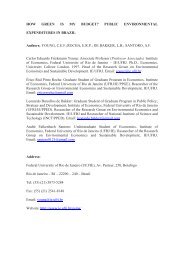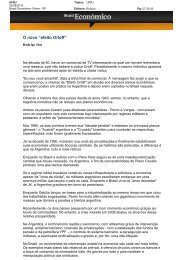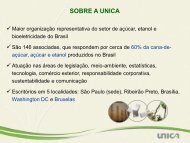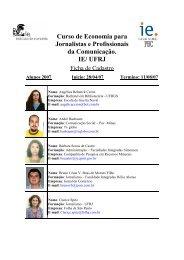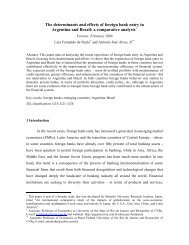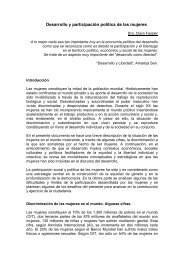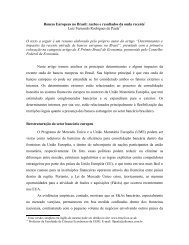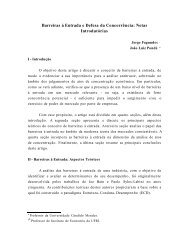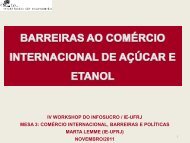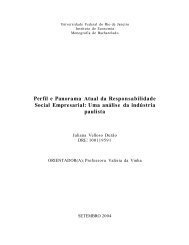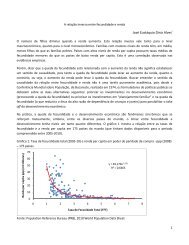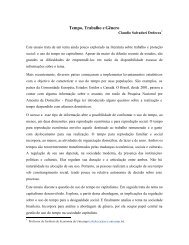Trade Integration for the Americas: What Can Economic Analysis ...
Trade Integration for the Americas: What Can Economic Analysis ...
Trade Integration for the Americas: What Can Economic Analysis ...
- No tags were found...
Create successful ePaper yourself
Turn your PDF publications into a flip-book with our unique Google optimized e-Paper software.
June 2006<strong>Trade</strong> <strong>Integration</strong> <strong>for</strong> <strong>the</strong> <strong>Americas</strong>: <strong>What</strong> <strong>Can</strong> <strong>Economic</strong> <strong>Analysis</strong>Tell Us?byWilliam Tyler *Universidade do Estado do Rio Janeiro (UERJ)AbstractMuch recent discussion - both analytical and polemic - has centered around <strong>the</strong>general topic of trade integration of <strong>the</strong> <strong>Americas</strong> and various <strong>for</strong>ms of tradingarrangements that such integration might take, including such diverse arrangementsas <strong>the</strong> MERCOSUL, NAFTA, <strong>the</strong> proposed FTAA, CAFTA, <strong>the</strong> United States’bilateral FTAs with different countries, etc. The paper presents an analyticaldiscussion of <strong>the</strong> economic benefits and costs of such arrangements. The use ofcomputable general equilibrium (CGE) models is discussed, and a presentation ismade of various simulation results. In general, <strong>the</strong> analytical findings are that <strong>the</strong>FTAA would bring greater benefits to its members than bilateral FTAs, but asuccessful Doha Round could bring even greater welfare improvements <strong>for</strong>Western Hemisphere countries.I. IntroductionIn <strong>the</strong> years immediately following World War II <strong>the</strong> international trading system,as depicted by <strong>the</strong> agreed rules of <strong>the</strong> GATT and <strong>the</strong> WTO, embodied multilateralism,with its emphasis on nondiscrimination of trade policies among countries. In o<strong>the</strong>r words,<strong>the</strong> most-favored nation rule applied, whereby a trade concession granted by one countryto ano<strong>the</strong>r was extended to all “most favored nations” (MFNs). The successive rounds ofmultilateral trade negotiations, held under <strong>the</strong> institutional auspices of <strong>the</strong> GATT/WTO,succeeded in substantially decreasing trade barriers and opening markets.Recent years however have witnessed a weakening of multilateralism in tradearrangements. The number of regional trade agreements (RTAs) has increased markedly,mostly in <strong>the</strong> <strong>for</strong>m of free trade areas (FTAs), as opposed to deeper economic integrationin <strong>the</strong> <strong>for</strong>m of customs unions <strong>for</strong>mation (with a common external tariff and o<strong>the</strong>rpossible features). As of December 2005, <strong>the</strong> United States had entered into seven suchfree trade agreements (NAFTA, CAFTA and separate bilateral free trade agreements withIsrael, Jordan, Singapore, Chile and Australia). The European Union, whose growth and* Visiting Professor of <strong>Economic</strong>s, Universidade do Estado do Rio de Janeiro (UERJ). An earlier versionof this paper was presented at <strong>the</strong> 2006 Meetings of <strong>the</strong> Latin American Studies Association, held inSan Juan, Puerto Rico, March 2006. The author expresses his gratitude to <strong>the</strong> Fundação de Amparo àPesquisa do Estado do Rio de Janeiro (FAPERJR) <strong>for</strong> generous financial support and to Jan Peter Wogart<strong>for</strong> helpful comments. Author’s Email address: wtyler@attglobal.net.
2success has motivated <strong>the</strong> <strong>for</strong>mation of many RTAs, has entered into 50 separate RTAs,31 of which are with developing country partners entered into since 1989. 1The worldwide proliferation of RTAs in recent years is dramatically demonstratedin Table 1. Under prevailing international rules, GATT/WTO must be notified of <strong>the</strong><strong>for</strong>mation of a regional trade agreement. The number of RTAs in goods made effectiveand notified to <strong>the</strong> GATT/WTO during <strong>the</strong> period 1958-2005 reached 141, with 63 ofthose taking place since 1990. The <strong>for</strong>mation of RTAs has accelerated in recent years.These arrangements include agreements among or between developed countries,developing countries, and developed and developing countries, with no apparent timetrends among those types of arrangements. The <strong>for</strong>mation of RTAs in goods has beenaccompanied by RTAs <strong>for</strong> trade in services. There are presently 131 notified RTAs in<strong>for</strong>ce; of those 109 are intended to be free trade areas (FTAs) and 11 are, or have <strong>the</strong> goalof becoming, customs unions. 2 The remaining 11 RTAs are partial scope arrangements,some of which are intended to eventually become FTAs. These RTAs have emerged inall <strong>the</strong> world’s regions, but are especially prevalent in Asia and <strong>the</strong> Western Hemisphere.Table 1: Regional <strong>Trade</strong> Agreements (RTAs) in Goods* by Date of Effectivenessand Type of Partner, 1958-February 2005Dates Total ofwhich:Developed-DevelopedDeveloped-DevelopingDeveloping-Developing1958-69 4 2 0 21970-89 21 8 6 71990-99 53 6 10 92000-05 63 2 20 12Total: 141** 18 36 30Notes: * as notified to <strong>the</strong> WTO.** Sums do not add across types because of omission of transitioncountries.Source: WTO (www.wto.org) and Craw<strong>for</strong>d and Fiorentino (2005). .In <strong>the</strong> case of <strong>the</strong> <strong>Americas</strong>, <strong>the</strong> experience with RTAs dates back to <strong>the</strong> 1960s,which saw <strong>the</strong> <strong>for</strong>mation of <strong>the</strong> ambitious Latin American Free <strong>Trade</strong> Association(LAFTA), <strong>the</strong> Central American Common Market (CACM), and <strong>the</strong> Andean Pact. (SeeAnnex Table A1 <strong>for</strong> a listing and description of <strong>the</strong> major RTAs in <strong>the</strong> <strong>Americas</strong>.) Theseearly RTAs are ei<strong>the</strong>r now conveniently <strong>for</strong>gotten failures (e.g., LAFTA) or arrangementswhich have had problematic histories with slow progress in terms of trade integration.The Caribbean Community arrangement (CARICOM), despite low levels of intrabloctrade, has emerged, among <strong>the</strong> early RTAs (i.e., those originating be<strong>for</strong>e <strong>the</strong> 1990s) as asuccess. The 1990s saw <strong>the</strong> <strong>for</strong>mation of MERCOSUL and NAFTA, both of which have1 In<strong>for</strong>mation on existing RTAs is available on <strong>the</strong> WTO website (www.wto.org).2 Craw<strong>for</strong>d and Fiorentino (2005), p. 3. Intention is a matter of interpretation. Practically all FTAs arephased in over time, frequently up to 20 years.
4Aside from <strong>the</strong> proliferation itself of preferential trade arrangements two trendsare apparent: (a) <strong>the</strong> proportional increase in <strong>the</strong> number of cross-regional RTAs; and (b)<strong>the</strong> gradual emergence of continent-wide regional trading blocs. These trends, due in partto a fading international leadership <strong>for</strong> multilateralism, have adverse implications <strong>for</strong> anopen, transparent and nondiscriminatory multilateral system of tradeThe remainder of this paper discusses <strong>the</strong> appeal and economic effects of regionaltrade agreements in Section II. Section III examines <strong>the</strong> measurement and evaluation ofthose effects, followed by a presentation in Section IV of some general analyticalfindings and implications <strong>for</strong> <strong>the</strong> <strong>Americas</strong>.II. <strong>Economic</strong> Effects of Regional <strong>Trade</strong> AgreementsThe primary motivations <strong>for</strong> seeking entrance into RTAs may not be economic,but ra<strong>the</strong>r political in nature. Country governments are driven by security considerations– both intraregional and extraregional. Such considerations frequently weigh heavily asreasons to enter into an RTA. The most obvious example is <strong>the</strong> impetus behind Europeaneconomic integration following World War II. Similarly, a country’s internationalbargaining power may be increased with its entrance into a RTA, and such an associationmay also enhance its prospects <strong>for</strong> obtaining cooperation on such things as commonprojects and environmental concerns. Moreover, <strong>the</strong> entrance into a RTA may provide abasis <strong>for</strong> a country government to lock in policy re<strong>for</strong>ms; such an incentive is exemplifiedby <strong>the</strong> Mexican quest <strong>for</strong> a FTA with <strong>the</strong> United States, which resulted in NAFTA.<strong>Economic</strong> advantages may also constitute an important appeal <strong>for</strong> a country toseek entrance into a RTA. On <strong>the</strong> trade side, <strong>the</strong> benefits from trade creation are offsetby <strong>the</strong> welfare costs of trade diversion. New markets may become accessible as a resultof an RTA, but losses may be incurred from diverting imports from <strong>the</strong> lowest costprovider to RTA partners. Assessing <strong>the</strong> balance between trade expansion and diversioneffects, amply discussed in <strong>the</strong> <strong>the</strong>oretical literature, has driven much of <strong>the</strong> empiricaleconomic analysis on RTAs. In addition to trade creation/diversion effects, a country’sterms of trade may also be affected by adhering to a RTA; those effects are a matter ofprice elasticities <strong>for</strong> <strong>the</strong> country’s products and its traded goods. The RTA’s impact on acountry’s economic welfare will depend inter alia on whe<strong>the</strong>r <strong>the</strong> terms of trade improveor deteriorate as a result of entry into <strong>the</strong> RTA. Less apparent, but equally important, are<strong>the</strong> indirect effects relating to changes in demand, supply and prices across sectors in <strong>the</strong>economy, All of <strong>the</strong>se static effects impact <strong>the</strong> country’s economic welfare.A RTA may also bring positive pro-competitive effects, including economies ofscale, greater efficiency and increased productivity. Increased inducements <strong>for</strong>investment may exist with a larger and more competitive market, and <strong>for</strong>eign directinvestment (FDI) may also increase. Indeed, one of <strong>the</strong> major effects <strong>for</strong> Mexicoderiving from NAFTA has been an increase in FDI. Similarly, greater (or lesser) marketcompetition may bring about changes in market structure and industrial organization. By
5<strong>the</strong> same token, but <strong>for</strong> reasons of sectoral production changes, changes in industriallocation and regional effects may also accompany a RTA (or, <strong>for</strong> that matter, trade policyliberalization or de-liberalization).III. Assessing <strong>the</strong> Impact of Regional <strong>Trade</strong> ArrangementsA. Computable General Equilibrium (CGE) ModelsIn assessing <strong>the</strong> effects of different trade policy arrangements, including regionaltrade agreements, three different, but complementary, types of economic analyses areappropriate and well suited. They involve <strong>the</strong> use of (a) computable general equilibrium(CGE) models and, secondly (b) sectoral studies founded on partial equilibrium analysis,undertaken to go beyond <strong>the</strong> insights af<strong>for</strong>ded by CGE work and provide greater sectoraldetail and understanding. A third analytical tool – gravity models – also is pertinent andwill be discussed below. Quantification of <strong>the</strong> effects of trade policy changes is desirablein order to best assess <strong>the</strong> magnitudes of effects, <strong>the</strong> trade-offs and benefits/costs todifferent policy alternatives. The use of CGE models and sector studies complement eacho<strong>the</strong>r in terms of <strong>the</strong>ir quantitative results. (See Table 3 below.) Some important effectsof RTAs however are essentially non-economic or political, as indicated above. Theseeffects can not be quantified.Major Features of CGE Models. Over <strong>the</strong> past twenty years <strong>the</strong> use of CGEmodels has become commonplace in order to assess <strong>the</strong> effects – both direct and indirect– of economic shocks or policy changes. Advances in computational techniques havefacilitated <strong>the</strong> use of such models. The basic idea underlying a CGE modeling exercise isrelatively simple. It involves: (a) <strong>the</strong> construction of a ma<strong>the</strong>matical model of aneconomy; (b) <strong>the</strong> collection of data <strong>for</strong> a time period <strong>for</strong> those variables <strong>for</strong> which dataare available; (c) calibration and solution of <strong>the</strong> model ma<strong>the</strong>matically to establish <strong>the</strong>initial equilibrium values; (d) imposition of a shock to <strong>the</strong> initial equilibrium in <strong>the</strong> <strong>for</strong>mof some exogenous event, such as a policy change; and (e) <strong>the</strong> observation of simulationsderived from <strong>the</strong> introduction of <strong>the</strong> shock on various variable values.CGE models are founded on Walrasian general equilibrium <strong>the</strong>ory in whichmarket prices and quantities are simultaneously determined. <strong>Economic</strong> agents comprisingfirms, households and government make economic decisions related to production andconsumption <strong>for</strong> different goods and services. Equilibrium conditions are established in<strong>the</strong> multiple goods and services markets such that demand and supply conditionsdetermine prices and quantities. Factor markets – generally specified as land (<strong>for</strong>agriculture), capital and labor – are similarly specified. CGE models are general in <strong>the</strong>sense that <strong>the</strong>y include all <strong>the</strong> economy’s sectors and economic agents. Consequently,upon solution all <strong>the</strong> effects – direct and indirect – of a given shock can be assessed.
6Table 3: Quantification of <strong>the</strong> Effects from RTAs: CGEs vs. Sector StudiesSectorEffectsCGE Models Studies<strong>Economic</strong> Effects:Static <strong>Economic</strong> Effects:<strong>Trade</strong> creation and diversion XX XTerms of trade XX XCross sectoral effects XX XNet changes in welfare/GDP XX XScale and Dynamic Effects:Pro-competitive effects X XXEconomies of scale X XXEfficiency/Productivity X XXInvestment X XXForeign direct investment N XMarket structure and industrial organization N XIndustrial location and regional effects N XNon-<strong>Economic</strong>/Political Effects:Enhanced Intraregional Security N NEnhanced Extraregional Security N NIncreased Bargaining Power N NImproved Regional and Project Cooperation N NLocking in Re<strong>for</strong>ms N NNote and Key:XX quantifiable effectsX limited measurement, some quantification possibleN no quantification possible.Source: Author’s elaboration.The advantages in <strong>the</strong> use of CGE models <strong>for</strong> policy simulations are several. First,such models are based upon solid microeconomic <strong>the</strong>oretical foundations. Second, <strong>the</strong>yare complete in that <strong>the</strong>y model <strong>the</strong> entire economy and can be used to capture andestimate total effects, taking into account interdependencies and linkages imbedded in <strong>the</strong>functioning of <strong>the</strong> economy. Third, CGE models generate quantifiable results <strong>for</strong> <strong>the</strong>impact of policy changes, including <strong>for</strong> output, resource allocation, and welfare. Incomedistributional implications can also be simulated. Fourth, since policy impacts arequantitatively estimated, analyses of alternative policy packages can be assessed andranked in a consistent framework. Fifth, CGE models are well suited to analyze majorpolicy changes as opposed to minor or marginal changes.While <strong>the</strong> advantages of CGE models are powerful, serious shortcomings are alsopresent. First, CGE models require massive and detailed data inputs, building upon anelaborate social accounting matrix framework, including household consumer surveys,national account in<strong>for</strong>mation, fiscal data, trade flow and restriction in<strong>for</strong>mation, etc., <strong>for</strong><strong>the</strong> multiple regions (or countries) being modeled. Since <strong>the</strong> reliability of such secondarydata is often questionable, models employing such data to construct a benchmark periodequilibrium possess no real means to test <strong>the</strong> model structure, as is frequently possible
7with <strong>the</strong> statistical testing of econometric models. Moreover, <strong>the</strong> simulation results willbe heavily dependent upon <strong>the</strong> benchmark year data, as well as <strong>the</strong> model parameters andany o<strong>the</strong>r related assumptions. Second, <strong>the</strong> aggregation in CGE models, normallymandated by data limitation considerations, may mask important effects in anysimulation. In o<strong>the</strong>r words, sectoral detail can not reasonably be expected from CGEmodels. Third, <strong>the</strong> more elaborate and detailed <strong>the</strong> CGE model, <strong>the</strong> more likely it is tobecome a “black box” <strong>for</strong> which result interpretation is difficult. Fourth, <strong>the</strong>re is no timedimension in a CGE model. The supposition is that with <strong>the</strong> imposed shock (e.g., policychange) <strong>the</strong> economy moves from one equilibrium to ano<strong>the</strong>r. How long this adjustmenttakes is a matter of judgment. Fifth, <strong>the</strong>re is no financial sector in CGE models. Sixth,and very importantly, despite ef<strong>for</strong>ts to dynamize CGE models, <strong>the</strong>y are essentiallycomparative static models.Use of CGE Models in Policy Simulations. While initially confined touniversities and research institutions, CGE models are now also widely used bygovernments to assess <strong>the</strong> impacts of policy changes. A recent survey estimated thatgovernment CGE modeling capability and use were present in at least 20 countriesaround <strong>the</strong> world. 3 Policy simulation impact analysis using CGE models has taken placeto assess trade policy changes, public finance and fiscal re<strong>for</strong>m, agriculture, migration,labor market issues, income distribution and structural re<strong>for</strong>m. With time and <strong>the</strong>improvement of modeling and computational techniques, <strong>the</strong> models have become moresophisticated, increasingly realistic and, at <strong>the</strong> same time, more difficult to interpret. The“first generation” of CGE models generally assumed that all markets were perfectlycompetitive, while a “second generation” of models has been able to include increasingreturns to scale and imperfect competition, <strong>the</strong>reby enabling <strong>the</strong> models to better reflectscale economy and competitive effects. “Third generation” CGE models have sought toendogenize some dynamic effects, including allowing <strong>for</strong> investment, productivitygrowth and externalities related to trade.When <strong>the</strong>se different generations of CGE models are used to assess <strong>the</strong> impact ofregional trade and integration arrangements, <strong>the</strong> more simple “first generation” modelsgenerally show that most RTAs have positive, but very small, aggregate welfare effects.The net effect of trade creation and trade diversion effects, as simulated with suchmodels, has generally run less than 1 percent of GDP. The use of “second generation”models have increased <strong>the</strong> measured gains to an order of about 2-3 percent of GDP, while“third generation” models have presented net gains in <strong>the</strong> magnitude of around 4-5percent of GDP. 4 A recent study of Mexico’s entrance into NAFTA, in part based upon a“third generation” CGE model, has concluded that Mexico’s GDP has increased by 4-5percent of GDP as a result of NAFTA membership. 53 Shantayanan Devarajan and Sherman Robinson, “The Influence of Computable General EquilibriumModels on Policy,” International Food Policy Research Institute, TMD Discussion Paper No. 98 (August2002).4 For a discussion, see World Bank, <strong>Trade</strong> Blocs: A World Bank Policy Research Report (New York:Ox<strong>for</strong>d University Press, 2000) and Harrison, Ru<strong>the</strong>r<strong>for</strong>d and Tarr (2004).5 World Bank, Lessons from NAFTA <strong>for</strong> Latin America and <strong>the</strong> Caribbean: A Summary of ResearchFindings (Washington: World Bank, 2003).
8A Case Study Example of CGE Modeling: Results of Policy Simulations <strong>for</strong> a Peru-USFTA and FTAALike many o<strong>the</strong>r Latin American countries, Peru has faced policy choicesregarding different options <strong>for</strong> trade policy arrangements. CGE models have been usedto analyze those choices: (a) unchanged present policies; (b) a Peru-US FTA; (c)Peruvian adherence to <strong>the</strong> FTAA; (d) continuation of <strong>the</strong> soon to be phase out USnonreciprocal preferential arrangement <strong>for</strong> Peru (ATPDEA); and (e) o<strong>the</strong>r conceivablearrangements. For illustrative purposes, <strong>the</strong>se CGE modeling ef<strong>for</strong>ts and <strong>the</strong>ir basicresults are presented below.Universidad Católica. A basic CGE model has been established by a team ofeconomists in <strong>the</strong> Department of <strong>Economic</strong>s of <strong>the</strong> Pontifícia Universidad Católica delPerú (PUCP). The model in use so far is a static model incorporating assumptions ofperfect competition and constant returns to scale. Ef<strong>for</strong>ts are currently ongoing to extend<strong>the</strong> model to incorporate increasing returns to scale and imperfect competition <strong>for</strong> <strong>the</strong>manufacturing sector and to include some dynamic elements. The model used so faremploys <strong>the</strong> GTAP5 database and is calibrated <strong>for</strong> 11 regions and 8 sectors. The baseyear (or initial equilibrium) is <strong>for</strong> 1997 (dependent upon <strong>the</strong> database availability). Themodeling ef<strong>for</strong>t has been institutionalized at PUCP, and expectations are thatimprovements, including data updating, will be gradually incorporated.While <strong>the</strong> ongoing modeling ef<strong>for</strong>t is also intended <strong>for</strong> o<strong>the</strong>r policy simulations,some initial (and still preliminary) simulations have been undertaken <strong>for</strong> differingregional trade policy arrangements. The overall simulation results <strong>for</strong> ATPDEA and <strong>the</strong>FTAA are presented below in Table 4. 6 Simulated sectoral production results arepresented in Annex Table A2; <strong>the</strong> sectors where expansion is <strong>the</strong> highest includetextiles/clothing and food products. Simulations were also undertaken <strong>for</strong> <strong>the</strong> effects ofPeru joining a genuine free trade area <strong>for</strong> <strong>the</strong> Andean Community and <strong>for</strong> a free tradezone <strong>for</strong> South America. In both of <strong>the</strong>se cases, <strong>the</strong> net positive welfare effects <strong>for</strong> Peruare substantially less than <strong>for</strong> <strong>the</strong> FTAA. This result is consistent with o<strong>the</strong>r work alsoshowing that <strong>the</strong> benefits <strong>for</strong> <strong>the</strong> South (or developing countries) are generally greaterwith entering into RTAs with <strong>the</strong> North (or industrialized countries) than with o<strong>the</strong>rSou<strong>the</strong>rn countries. 7Inter-American Development Bank (IDB). Over <strong>the</strong> past several years <strong>the</strong> IDB’s<strong>Integration</strong> and Regional Programs Department has assembled a small team ofeconomists charged with developing a CGE modeling framework primarily <strong>for</strong> <strong>the</strong>purpose of analyzing regional trading arrangements and initiatives. A Latin Americanbased CGE model has been developed. While <strong>the</strong> GTAP5 database is used as a starting6 For a summary of <strong>the</strong> preliminary results, see Gabriela Cuadra et al., “Escenarios de Integración para elPerú en la Economia Mundial,” PUCP, Presentación hecha em Power Point en Septiembre 2003. Nosimulation results are yet available <strong>for</strong> <strong>the</strong> proposed Peru-US FTA.7 One such study is Monteagudo and Watanuki, “An Empirical Assessment of North-South and South-South Agreements <strong>for</strong> Latin America,” IDB Working Paper, November 2003.
9reference point, <strong>the</strong> IDB database is built upon national social accounting matrixes(where possible), and <strong>the</strong> trade and trade restrictions in<strong>for</strong>mation come from <strong>the</strong>hemispheric database assembled by <strong>the</strong> IDB in conjunction with <strong>the</strong> ongoing FTAAdiscussions. Different exercises have involved different regional and sectoral groupings,although <strong>the</strong> basic model runs with 15 productive sectors. The year 1997 is taken as <strong>the</strong>base year. Ef<strong>for</strong>ts to make <strong>the</strong> modeling framework more dynamic have included <strong>the</strong>incorporation of elasticities <strong>for</strong> trade flows and productivity to reflect positiveexternalities linked to trade. Ongoing work to extend <strong>the</strong> modeling framework includesef<strong>for</strong>ts to include increasing returns to scale and imperfect competition <strong>for</strong> manufacturingsectors.Using this CGE framework and <strong>the</strong> IDB hemispheric trade database, and anumber of different simulations have been undertaken. 8 Some basic simulation resultsare presented in Table 4. Un<strong>for</strong>tunately, separate estimates <strong>for</strong> Peru are not yet availablefrom <strong>the</strong> IDB work. 9 The simulation results presented in Table 4 <strong>for</strong> Peru+ include <strong>the</strong>grouping of Peru, Ecuador and Bolivia. Since Peru accounts <strong>for</strong> about two-thirds of <strong>the</strong>collective GDP <strong>for</strong> this group of countries, <strong>the</strong> results are presumably representative <strong>for</strong>Peru.Table 4: CGE Simulations under Different Regional <strong>Trade</strong> Policy Agreements:Estimated Effects <strong>for</strong> Peru (changes in %)Universidad Católica IDB (Peru +) 1Impacted Variable ATPDEA FTAA US FTA FTAAGDP 0.06% 0.27% 1.78% 2.98%Total Exports 2.1 9.7 4.4 8.3Total Imports 2.1 10.0 4.0 7.5Exports to FTA Partners 22.6 26.1 n.a. n.a.Imports from FTA Partners 2.6 26.9 n.a. n.a.Notes: 1. For <strong>the</strong> IDB simulations Peru+ also includes <strong>the</strong> smaller economies of Bolivia and Ecuador.Sources: Gabriela Cuadra et al., “Escenarios de Integración para el Perú en la Economia Mundial,” PUCP,Presentación hecha en Power Point en Septiembre 2003 and Monteagudo and Watanuki, “An EmpiricalAssessment of North-South and South-South Agreements <strong>for</strong> Latin America,” IDB Working Paper,November 2003.Comparing <strong>the</strong> simulations made with <strong>the</strong> PUCP and IDB CGE models, a numberof observations are relevant. First, it would appear, as expected that <strong>the</strong> ATPDEA, US-Peru FTA and <strong>the</strong> FTAA are all beneficial <strong>for</strong> Peru. GDP is seen to increase in all cases.8 Inter-American Development Bank, Beyond Borders: The New Regionalism in Latin America, <strong>Economic</strong>and Social Progress in Latin America: 2002 Report (Washington: Inter-American Development Bank,2002), pp. 52-55. O<strong>the</strong>r IDB reporting on CGE simulations is contained in various papers by Monteagudoand Watanuki, op cit., as cited in this note’s list of references.9 Some very preliminary IDB results were presented in a workshop in MINCETUR in September 2003. Thepresentation however contained incomplete results and posed questions of consistency with o<strong>the</strong>r IDBsimulations. See Monetagudo et al., “Impacto de Diferentes Estrategias Hemisféricas en el Comercio dePerú,” Power Point presentation made September 18-19, 2003.
10Second, as simulated by <strong>the</strong> PUCP and IDB models, total Peruvian exports increase with<strong>the</strong> FTAA by roughly similar amounts. Third, as expected, exports increase more with <strong>the</strong>FTAA than with <strong>the</strong> US-Peru FTA. The opening of Latin American markets is important<strong>for</strong> expanding Peruvian exports, and this of course is not provided with <strong>the</strong> bilateral FTAwith <strong>the</strong> US. Fourth, <strong>the</strong> net welfare gains to Peru (as represented by GDP growth) areseen as greater under <strong>the</strong> IDB model simulations as opposed to <strong>the</strong> PUCP simulations.The explanation <strong>for</strong> this is <strong>the</strong> inclusion of some dynamic effects into <strong>the</strong> IDB CGEmodel.Andean Community. The headquarters of <strong>the</strong> Andean Community has recentlyundertaken an analytical ef<strong>for</strong>t to assess <strong>the</strong> impact of different regional tradearrangements on <strong>the</strong> Andean Community countries. This ef<strong>for</strong>t has involved contractingan international consultant to undertake some CGE model based simulations. 10 The CGEmodel used is based upon <strong>the</strong> GTAP5 framework and database, employing 10 productivesectors and with separate breakouts <strong>for</strong> <strong>the</strong> Andean Community countries (althoughEcuador and Bolivia are lumped toge<strong>the</strong>r <strong>for</strong> data availability reasons). The simulationsare first made of <strong>the</strong> effects of <strong>the</strong> ATPDEA (which, as expected, show positive netbenefits in terms of consumption and welfare, along with expanded trade flows) <strong>for</strong> bothPeru and Colombia, as well as <strong>for</strong> <strong>the</strong> Andean Community as a whole. There aredifficulties in assessing <strong>the</strong> results <strong>for</strong> <strong>the</strong> ensuing FTAA simulations, however. Thosesimulations are based upon an initial equilibrium with <strong>the</strong> ATPDEA effects incorporatedin <strong>the</strong> base. In reality, <strong>the</strong>re is no sequential choice <strong>for</strong> <strong>the</strong> Andean Community countriesbetween sticking with ATPDEA or joining <strong>the</strong> FTAA. The ATPDEA provisions, grantedby <strong>the</strong> US government, are time bound, with expiration scheduled <strong>for</strong> 2006. In addition,even if <strong>the</strong> ATPDEA benefits were unilaterally extended by <strong>the</strong> US, <strong>the</strong>re is no guaranteethat <strong>the</strong>y would be permanent. The US could withdraw <strong>the</strong>m at any time, whereas ei<strong>the</strong>ran FTA or <strong>the</strong> FTAA would reduce this uncertainty with stipulated treaty commitments.B. Sectoral StudiesSector studies of trade policy effects, building upon partial equilibrium analysis,complement and extend in greater detail <strong>the</strong> indicative results from CGE models. Bothtypes of approaches are useful in assessing <strong>the</strong> impact stemming from alternative tradepolicy arrangements, such as a RTA. In most Latin American countries <strong>the</strong>re are variedindividual sector studies available <strong>for</strong> different sectors, but <strong>the</strong>se studies are seldomfocused on <strong>the</strong> impact of possible trade liberalization or o<strong>the</strong>r changes in trade policyarrangements. Indeed, some common special features and characteristics are central ifsector studies are to be useful to policy-makers in <strong>the</strong> discussion and negotiation ofdiverse RTAs.Questions that should be posed in such analytical work involving specific sectorsinclude <strong>the</strong> following:10 Comunidad Andina, Analisis del Impacto del ALCA en la Comunidad Andina (Lima: Secretaria Generalde la Comunidad Andina, 2003).
111. <strong>What</strong> are <strong>the</strong> sector specific net welfare gains accruing to <strong>the</strong> country as a resultof adherence to <strong>the</strong> proposed RTA? <strong>What</strong> are <strong>the</strong> related production effects likelyto result from <strong>the</strong> RTA? Using partial equilibrium analysis, sector specificwelfare changes stemming from <strong>the</strong> RTA can be estimated. <strong>Trade</strong> creation anddiversion can be determined and quantified, along with changes in producersurplus, consumer surplus and tariff revenues. Significant sector knowledge andunderstanding – both in <strong>for</strong> <strong>the</strong> country in question and <strong>the</strong> prospective RTApartners – are required to model and quantitatively estimate <strong>the</strong>se changes. Pricecomparisons in <strong>the</strong> work are critical, implying much greater ease of analysis <strong>for</strong>more standardized products. In <strong>the</strong> case of a FTA with <strong>the</strong> US, <strong>the</strong> analysis shouldinvolve <strong>the</strong> use of domestic prices, US prices and international prices. The pricechanges associated with <strong>the</strong> FTA can be simulated along with <strong>the</strong>ir production,trade, consumption and revenue effects. 112. For those sectors where output and/or export expansion are anticipated as aresult of <strong>the</strong> RTA, is it likely that <strong>the</strong>re will be a supply response to ei<strong>the</strong>r <strong>the</strong>increased relative prices and a more competitive environment? <strong>What</strong> are <strong>the</strong>impediments to <strong>the</strong> sector’s supply response? A properly done sector should beable to identify such impediments, which may be caused by market imperfections,domestic regulation, institutional rigidities, or o<strong>the</strong>r market distortions.Recommendations as to how to deal with such impediments to market supplyresponse would be an important component <strong>for</strong> <strong>the</strong> envisaged sector studies.3. <strong>What</strong> are <strong>the</strong> sectoral employment effects likely to result from <strong>the</strong> RTA? WhileCGE simulation models can provide some notions of <strong>the</strong> employment effects,fur<strong>the</strong>r and more in-depth analysis may be necessary. CGE models are generallybased on perfect competition assumptions in labor markets, and also nodistinction is commonly made between labor – and skill – categories. In reality,<strong>the</strong>re may be considerable labor market rigidities or peculiarities which can not becaptured in more aggregative analyses. Since employment is of central concern toany government entering into a RTA, more in-depth analysis at <strong>the</strong> sector levelmay provide important insights <strong>for</strong> policy-makers.4. <strong>What</strong> are <strong>the</strong> implications of <strong>the</strong> RTA <strong>for</strong> market structure <strong>for</strong> <strong>the</strong> sector inquestion? And how might <strong>the</strong> existing market structure influence <strong>the</strong> outcome?Most manufactured and nontraditional service sectors are characterized byimperfect competition. Sector studies are necessary to examine <strong>the</strong> relationshipbetween market structure and trade. A RTA, <strong>for</strong> example, may make <strong>for</strong> a morecompetitive sector market and ei<strong>the</strong>r increase or diminish concentration. <strong>Analysis</strong>can be useful <strong>for</strong> policy <strong>for</strong>mulation.11 An illustrative case study is a sector study done recently by Gary Pursell <strong>for</strong> <strong>the</strong> Indian cement industry.See Gary Pursell, “Study of India-Bangladesh <strong>Trade</strong> and <strong>Trade</strong> Policies: Case Study Simulations of<strong>Economic</strong> Welfare Effects of a Free <strong>Trade</strong> Agreement,” World Bank working paper, December 2003.
125. <strong>What</strong> are <strong>the</strong> likely effects of <strong>the</strong> RTA on sector investment? And how might <strong>the</strong>RTA affect <strong>for</strong>eign direct investment? In sectors which expand as a result of anRTA, new investment is likely to occur. Examining how, how much, where andwhat type of investment is likely to occur can be addressed in sector studies.6. <strong>What</strong> are <strong>the</strong> likely effects of <strong>the</strong> RTA on productivity and technologicalenhancement? One commonly observed effect of more open trade policyenvironments is an increase of productivity. This may be because of increasedcompetitive pressures or <strong>the</strong> embodiment of productivity enhancing technology innew investment. Sector studies can usefully address related issues.7. <strong>What</strong> are <strong>the</strong> implications of <strong>the</strong> RTA <strong>for</strong> industrial location and geographicaldispersion? One frequently observed feature of trade liberalization is that certaingeographic regions may be negatively impacted. Sector studies can help identifyregions ei<strong>the</strong>r losing or gaining from a RTA.8. Finally, what can <strong>the</strong> Government do to enhance <strong>the</strong> gains <strong>for</strong> those sectorsbenefited by <strong>the</strong> RTA and to cushion and facilitate (but not <strong>for</strong>estall) adjustmentin negatively impacted sectors? Any proposed government interventions shouldbe seen as supporting <strong>the</strong> adjustment and transition to a more competitiveenvironment. They also should be budgeted and analyzed <strong>for</strong> cost effectiveness.There are several criteria available <strong>for</strong> selecting sectors that might be productivelyanalyzed. First, CGE simulations can indicate grosso modo which sectors are likely toexpand and to contract as a result of <strong>the</strong> RTA. (See Annex Table A2 <strong>for</strong> a Peruvianexample) The level of aggregation in <strong>the</strong> sector designation may hide important features,and more in<strong>for</strong>mation about <strong>the</strong> outlying expanding or contracting sectors can be useful<strong>for</strong> policy-makers. Both <strong>the</strong> identified major “winners” and “losers” from <strong>the</strong> RTA meritmore careful analysis than that af<strong>for</strong>ded from <strong>the</strong> CGE alone.A second criterion <strong>for</strong> selecting sectors <strong>for</strong> more in-depth analysis is to base thatconsideration on recent growth and export per<strong>for</strong>mance. How is <strong>the</strong> RTA likely to affectthat per<strong>for</strong>mance? Third, protection in <strong>the</strong> domestic market – including effectiveprotection – can be used as screening criterion <strong>for</strong> selecting sectors <strong>for</strong> study. With <strong>the</strong>presumed reduction in protection, what will happen? Or is that protection redundant?Fourth, sectors important <strong>for</strong> <strong>the</strong> economy can not be neglected, and policy-makerscharged with negotiating RTAs need to have a sense of what <strong>the</strong> impact may be on thosesectors. All four of <strong>the</strong>se criteria can be used to suggest some relevant sector studies tosupport a Government’s position <strong>for</strong> RTA negotiation.C. Gravity ModelsCommon sense has long told economists that geographical proximity is important<strong>for</strong> trade. Being close to your markets, everything else being equal, means lowertransportation costs (in both money and time) and easier access. It is also easier to tradewith those close-by if <strong>the</strong>y speak <strong>the</strong> same language and share similar cultures. For <strong>the</strong>se
13reasons, it is not surprising to find greater trade between neighbors than those located at agreater distance. On <strong>the</strong> basis of <strong>the</strong>se simple contentions and observations, gravitymodels of international trade have been developed. The basic notion (and equation) positsthat trade between countries is a function of distance and GDP, i.e., <strong>the</strong> smaller <strong>the</strong>distance between markets and <strong>the</strong> larger <strong>the</strong> market size (as measured by GDP), <strong>the</strong>greater will be <strong>the</strong> trade flows between <strong>the</strong>m. Empirically, <strong>the</strong> gravity models measuringbilateral trade in terms of variations of <strong>the</strong> distance and market size variables are veryrobust. 12 There is indeed a tendency <strong>for</strong> neighbors to trade more with each o<strong>the</strong>r than withthird, and more distant, parties.Gravity model estimation typically posits trade flows as a function of five basicexplanatory variables: market size, per capita incomes, distance, common borders andcommon languages. In general, in studying <strong>the</strong> <strong>for</strong>mation of RTAs ex post, RTAaffiliation accounts <strong>for</strong> a positive factor beyond <strong>the</strong> five basic explanatory variables in <strong>the</strong>equation. This is taken to imply benefits from RTA <strong>for</strong>mation.The limitations of gravity models to examine trade policy choices are fairlyevident. The models are best suited <strong>for</strong> examining bilateral trade and more difficultlyadapted <strong>for</strong> examining RTAs. The models measure trade flows, which are inherently lessinteresting than economic welfare, which is not measured. Moreover, gravity modelmeasurements are ex post ra<strong>the</strong>r than ex ante and <strong>the</strong>re<strong>for</strong>e have little predictive value.For <strong>the</strong>se reasons, gravity models, while capable of providing important insights, are notwidely used <strong>for</strong> examining <strong>the</strong> potential impact of different trade policy options orarrangements, including RTAs.IV. Some General Findings and Implications <strong>for</strong> <strong>the</strong> <strong>Americas</strong>A. The FTAA Option Once Again: Anything New?Ever since <strong>the</strong> Free <strong>Trade</strong> Association of <strong>the</strong> <strong>Americas</strong> (FTAA) was firstproposed in <strong>the</strong> early 1990s, it has been surrounded by controversy, mostly of a politicaland/or ideological nature. This political discussion has most frequently dominated <strong>the</strong>economic discussion. But <strong>the</strong>re are important economic dimensions as well. <strong>What</strong>, <strong>for</strong>example, can be expected to happen to <strong>the</strong> economic welfare <strong>for</strong> <strong>the</strong> prospective membercountries? Will Country X be better off or worse off? There is indeed some evidencefrom economic analysis, which, predictably enough, is largely ignored by <strong>the</strong> politicalactors.The evidence regarding <strong>the</strong> most relevant economic effects – those <strong>for</strong> economicwelfare – has been developed with <strong>the</strong> use of CGE models. Some illustrative evidence ispresented in Table 5. The results <strong>for</strong> two different studies are reported: (a) a study byHarrison, Ru<strong>the</strong>r<strong>for</strong>d, Tarr and Gurgel (hereafter termed HRTG) undertaken under <strong>the</strong>12 For a solid analysis of gravity models, along with a development of <strong>the</strong> implications <strong>for</strong> RTAs, seeFrankel (1997).
14auspices of <strong>the</strong> World Bank 13 and (b) work by <strong>the</strong> IDB referred to above in relation toPeru. The two ef<strong>for</strong>ts are different in terms of statics. The HRTG/World Bank model isstatic in nature (and <strong>the</strong>re<strong>for</strong>e underestimates gains), while <strong>the</strong> IDB ef<strong>for</strong>t attempts toinclude dynamic elements related to imperfect competition and externalities fromincreased trade. Unsurprisingly, <strong>the</strong> estimated impacts from <strong>the</strong> IDB exercise are larger.Table 5: Welfare Gains <strong>for</strong> Different RTAs, Selected Countries (% change)Country/RegionHRTG/WB CGE Model Estimates*50%MultilateralMercosul TariffFTAA -EU FTA ReductionFTAAIDB CGE Model Estimates**Mercosul-EU FTASAFTAAndeanComm.-US FTANAFTA 0.39 0.03 0.00 0.13Mexico 0.3 0.0 0.5 1.02 0.03 0.00 -0.05<strong>Can</strong>ada 0.0 0.0 0.2 0.57 0.04 0.00 -0.01United States 0.0 0.0 0.1 0.35 0.03 0.00 0.15Central Am. & Carib. 4.3 0.0 2.1 2.22 0.04 -0.01 -0.07Andean Community 2.12 0.12 0.62 1.36Colombia 1.7 -0.1 1.0 1.32 0.05 0.28 0.92Peru 1.0 0.1 1.3 -- -- -- --Venezuela 1.1 0.0 0.9 2.08 0.12 0.37 1.40MERCOSUL 3.12 4.72 0.50 -0.01Argentina -0.2 2.3 0.8 2.49 4.20 0.61 0.0Brazil 0.6 0.9 0.9 3.39 4.94 0.46 -0.01Chile 1.1 0.9 1.3 2.84 0.11 1.14 -0.01European Union -0.1 0.5 0.8 -0.01 0.61 0.0 0.0Notes: * Estimates from Harrison, Ru<strong>the</strong>r<strong>for</strong>d, Tarr and Gurgel (2003). Welfare gains are expressed as a percentage ofconsumption.** Estimates from Monteagudo and Watanuki (2003). Gains are expressed as a percentage of GDP. The SAFTArepresents a hypo<strong>the</strong>tical South American Free <strong>Trade</strong> Association.Source: Harrison, Ru<strong>the</strong>r<strong>for</strong>d, Tarr and Gurgel (2003); Monteagudo and Watanuki (2003).Turning first to <strong>the</strong> HRTG/World Bank estimates of welfare changes attributableto <strong>the</strong> <strong>for</strong>mation of <strong>the</strong> FTAA, we see that <strong>the</strong> greatest welfare gains accrue to CentralAmerica and <strong>the</strong> Caribbean (consistent also with a gravity model interpretation). Theseare small economies. For <strong>the</strong> US – a very large economy relative to <strong>the</strong> rest of <strong>the</strong> region– <strong>the</strong> gains are negligible (but not negative). For Mexico, already with access to <strong>the</strong> USmarket af<strong>for</strong>ded by NAFTA, <strong>the</strong> gains are modest and attributed to market access in thosecountries where it does not presently have a preferential trade arrangement. Larger gainsaccrue to Colombia, Peru, Venezuela, Chile and Brazil. The European Union – a13 The CGE model used <strong>for</strong> <strong>the</strong> HRTG/World Bank study has been developed and used by <strong>the</strong> World Bankin different <strong>for</strong>ms and guises <strong>for</strong> various exercises. It entails a constant returns to scale (CRTS) assumptionand employs <strong>the</strong> GTAP5 database, with, in this case, some modifications <strong>for</strong> Brazil. Simulations areundertaken <strong>for</strong> 32 sectors <strong>for</strong> a wide variety of countries and regions. For a description see HRTG (2003).
15nonmember – suffers a slight welfare loss as a result of <strong>the</strong> FTAA, stemming from <strong>the</strong>trade diversion associated with FTAA <strong>for</strong>mation.Argentina presents an interesting case with <strong>the</strong> HRTG estimates. It incurs a slightwelfare loss as a result of <strong>the</strong> FTAA. The most plausible explanation <strong>for</strong> this isArgentina’s loss of its privileged position in <strong>the</strong> Brazilian market previously stemmingfrom MERCOSUL trade diversion. The FTAA eliminates this gain <strong>for</strong> Argentina (andloss <strong>for</strong> Brazil). The HRTG result <strong>for</strong> Argentina is not however uni<strong>for</strong>mly obtained ino<strong>the</strong>r analyses. As also seen in Table 5, <strong>the</strong> IDB estimates show welfare gains <strong>for</strong>Argentina emanating from <strong>the</strong> FTAA. A roughly comparable CGE modeling exercisedone by <strong>the</strong> Argentine Government showed a similar welfare gain <strong>for</strong> Argentina fromFTAA accession. 14The IDB estimates tell <strong>the</strong> same basic story. Gains are experienced all around,except <strong>for</strong> <strong>the</strong> (excluded) European Union which incurs a small welfare loss resultingfrom trade diversion. The United States gains, but those gains are quite modest given <strong>the</strong>size of <strong>the</strong> American economy. The Central American and Caribbean countries also gain,but less relatively than in <strong>the</strong> HRTG study. Brazil, on <strong>the</strong> o<strong>the</strong>r hand, shows much largergains than with <strong>the</strong> HRTG estimates. Gains <strong>for</strong> Chile are also significant, but those gainsmay be overstated, because of <strong>the</strong> more recent RTA of Chile with <strong>the</strong> US – not factoredinto <strong>the</strong> analysis.If <strong>the</strong> benefits of <strong>the</strong> FTAA are so apparent <strong>for</strong> prospective member countries,why haven’t <strong>the</strong> negotiations been completed and <strong>the</strong> FTAA enacted? Aside frommisunderstandings, <strong>the</strong> ideological rant, and economic ignorance, <strong>the</strong>re are some genuineeconomic reasons why <strong>the</strong> FTAA has not come into fruition. Those reasons center onprotectionism. Some groups or activities would be negatively affected in all countries,and <strong>the</strong>se vested interests most commonly outweigh in <strong>the</strong>ir political voice and influencethose that would benefit from <strong>the</strong> FTAA. Even though <strong>the</strong> net benefits <strong>for</strong> anyprospective member country may be positive, this by no means assures that <strong>the</strong> politicalprocess surrounding negotiation, agreement and adoption will proceed. Groups opposedto <strong>the</strong> FTAA, <strong>for</strong> whatever reason, have proved effective so far in delaying or derailing<strong>the</strong> discussions. Clearly some of <strong>the</strong> arguments raised in <strong>the</strong> discussions have someeconomic merit; o<strong>the</strong>rs are mostly smokescreens.A major economic issue relates to <strong>the</strong> treatment of agriculture. While <strong>the</strong> USagricultural sector is generally very competitive, <strong>the</strong>re are some agricultural activities inwhich this is less so. In particular, <strong>the</strong> MERCOSUL countries are more competitive inmany gain products. In addition, <strong>the</strong> US heavily subsidizes many agricultural activities.Thus <strong>the</strong> elimination or reduction of agricultural subsidies plus market access <strong>for</strong>agricultural products is an important issue under discussion <strong>for</strong> <strong>the</strong> FTAA. The USposition is that agriculture-related issues are best discussed under <strong>the</strong> coming DohaRound of multilateral trade negotiations, where EU agricultural policies and subsidies14 CEI (2002). With a constant returns to scale assumption and <strong>the</strong> inclusion of trade relate externalities, <strong>the</strong>CEI CGE model simulations show that Argentina reaps a 1.3 percent of GDP gain as a result of <strong>the</strong> FTAA.
16will also be on <strong>the</strong> table. The Doha Round talks are also currently stalled. A related USargument is that <strong>the</strong> US can only provide concessions related to agriculture if <strong>the</strong>MERCOSUL countries make concessions related to <strong>the</strong> “behind <strong>the</strong> borders” issuesinvolving trade in services, intellectual property, government procurement, treatment ofinvestment flows, etc. And so <strong>for</strong>th. On <strong>the</strong> question of timing, <strong>the</strong>re may be somerationale to proceed with <strong>the</strong> Doha Round first, be<strong>for</strong>e finalizing a FTAA negotiation. 15Is <strong>the</strong> FTAA dead? The future of <strong>the</strong> FTAA, until recently planned <strong>for</strong> signing in2005, depends mainly on <strong>the</strong> approaches adopted <strong>the</strong> United States, on <strong>the</strong> one hand, andMERCOSUL, lead by Brazil, on <strong>the</strong> o<strong>the</strong>r. Protectionism in <strong>the</strong> US presents real issues<strong>for</strong> Congressional ratification of a FTAA agreement. The recently ratified CAFTA, ekedthrough <strong>the</strong> Congress by a narrow margin and only with heavy (and expensive) lastminute executive lobbying, shows how effective protectionist interests (in this case sugar)can be. In <strong>the</strong> case of <strong>the</strong> FTAA, <strong>the</strong> vested interests negatively impacted are much largerand powerful (going beyond, but including, sugar). A recent study has shown that in 37US states at least 20 percent of <strong>the</strong> Congressional Districts were affected by “sensitive”product imports from Brazil, which could be expected to increase with <strong>the</strong> FTAA; in 17states more than 60 percent of <strong>the</strong> Congressional Districts would be affected. 16 In manyof <strong>the</strong>se states, including <strong>the</strong> Farm Belt states, <strong>the</strong> governing Republican Party isespecially powerful. 17 It is apparent that political sensitivities and potential difficultieswith FTAA ratification are driving US policies with respect to <strong>the</strong> FTAA. This sensitivityand political calculus may be behind <strong>the</strong> US decision to pursue bilateral FTAs instead of<strong>the</strong> more ambitious (and beneficial) FTAA.US hesitancy in proceeding with <strong>the</strong> FTAA is more than matched by <strong>the</strong>MERCOSUL countries. In Brazil <strong>the</strong>re is a strong anti-FTAA lobby and influence in <strong>the</strong>current Government. This opposition to <strong>the</strong> FTAA includes both ideological andprotectionist elements. A clear rift on <strong>the</strong> FTAA exists within <strong>the</strong> present BrazilianGovernment, with reluctance to proceed on <strong>the</strong> part of <strong>the</strong> Ministry of Foreign Relations,which is charged with <strong>the</strong> negotiations. On <strong>the</strong> o<strong>the</strong>r hand, <strong>the</strong> Ministries of Agriculture,Development and Industry, see clear economic advantages <strong>for</strong> Brazil and are anxious toproceed. 18 In sum, <strong>the</strong> Brazilian Government has gone through <strong>the</strong> motions of reluctantly15 A good discussion of <strong>the</strong> negotiating issues and <strong>the</strong> question of timing is presented in Nogués (2005).16 Abreu (2005). “Sensitive” products were defined as orange juice, sugar and derivatives, tobacco, poultryproducts, beef, pork, cotton, soybeans, shoes and footwear, steel and trucks.17 The NAFTA agreement was ratified without <strong>the</strong> opposition of <strong>the</strong> agricultural lobby. Opposition camemostly from <strong>the</strong> more heavily democratic industrial states.18 In an important FTAA negotiating meeting held in Mexico in 2004, <strong>the</strong> Ministers of <strong>the</strong> Agriculture andDevelopment and Industry were not invited nor provided with <strong>the</strong> Government’s background andnegotiating documents. The Ministry of Foreign Relations instead invited labor union, indigenous groupand NGO representatives. The meeting ended in failure. After <strong>the</strong> meeting <strong>the</strong> left-out Ministerscomplained to <strong>the</strong> President, who in turn reaffirmed <strong>the</strong> authority of <strong>the</strong> Minister of Foreign Relations whilepromising greater participation in <strong>the</strong> discussions.
17negotiating <strong>the</strong> FTAA and in essence playing a waiting game in doing so. Theintransigence on <strong>the</strong> Brazilian side is matched by that of <strong>the</strong> present ArgentineGovernment and enthusiastically surpassed by <strong>the</strong> rhetoric and antics of <strong>the</strong> currentVenezuelan Government.To <strong>the</strong> question posed above of whe<strong>the</strong>r <strong>the</strong>re is anything new on <strong>the</strong> FTAA front,<strong>the</strong> answer is “not really.” But this is a pity <strong>for</strong> those countries in <strong>the</strong> <strong>Americas</strong>immediately concerned and potentially benefited.B. RTA Options: A MERCOSUL Free <strong>Trade</strong> Agreement (FTA) with <strong>the</strong> EuropeanUnionDiscussions regarding a possible free trade agreement between MERCOSUL and<strong>the</strong> European Union were initiated several years ago, but have proceeded very slowly.From <strong>the</strong> MERCOSUL standpoint a major concern was to have <strong>the</strong>se potentialarrangements as a possible bargaining counterweight in <strong>the</strong> discussions with <strong>the</strong> US on<strong>the</strong> FTAA, and, since <strong>the</strong> overall EU policy has been to seek fur<strong>the</strong>r liberalization andmarket access through new RTAs with <strong>the</strong> EU, negotiations have proceeded with intereston both sides.Evidence on <strong>the</strong> welfare impact of a possible MERCOSUL-EU FTA, as simulatedthrough CGE modeling, is presented in Table 5. The HRTG/World Bank estimates shownet welfare benefits <strong>for</strong> <strong>the</strong> MERCOSUL countries, and especially <strong>for</strong> Uruguay, withsuch an arrangement. Indeed, as seen in Table 5, those benefits <strong>for</strong> MERCOSUL exceedthose from <strong>the</strong> FTAA. 19 The EU, predictably, also benefits from <strong>the</strong> FTA. The IDBestimates, presented in Table 5’s data columns 4 and 5, show a similar story. ForMERCOSUL a FTA with <strong>the</strong> EU would bring greater net benefits than <strong>the</strong> FTAA. This isdue primarily to <strong>the</strong> MERCOSUL potential <strong>for</strong> expanding agricultural exports to <strong>the</strong>protected EU market in those products. If trade restraints are however placed on thoseproducts, <strong>the</strong> benefits are accordingly reduced.The main economic issues in <strong>the</strong> MERCOSUL-EU negotiations are quite similarto those deadlocking <strong>the</strong> FTAA discussions. 20 MERCOSUL seeks concessions onagricultural products – both in terms of market access and subsidies provideddomestically and <strong>for</strong> export by <strong>the</strong> EU. The EU, on <strong>the</strong> o<strong>the</strong>r hand, has sought greater19 HRTG also undertook estimates of <strong>the</strong> welfare effects if MERCOSUL were to enter into both a FTAAand a FTA with <strong>the</strong> EU. In this case, <strong>the</strong> net benefits would exceed <strong>the</strong> sum of welfare benefits estimatedseparately. This occurs because of reduced trade diversion with both agreements in place.20 It can be noted that politically MERCOSUL has less of a problem negotiating with <strong>the</strong> EU than <strong>for</strong> <strong>the</strong>FTAA. With <strong>the</strong> latter, dealing with <strong>the</strong> US has a negative political image and accordingly presentsdomestic political constraints. <strong>Economic</strong>ally, however, dealing with <strong>the</strong> EU may be more difficult becauseof <strong>the</strong> European Common Agricultural Policy (CAP) and its imbedded protectionism. Also it should benoted that <strong>the</strong> EU has negotiated a number of bilateral RTAs (e.g., Morocco, Tunisia) where it hassubstantial regional political interests (and presumably more compelling reasons <strong>for</strong> granting economicconcessions). Yet, in none of <strong>the</strong>se RTAs were <strong>the</strong>re substantial agricultural product concessions on <strong>the</strong>EU’s part.
18access <strong>for</strong> its services and manufactured goods and concessions on <strong>the</strong> so-called “behind<strong>the</strong> borders” issues such service regulation, investment issues, and governmentprocurement. As with <strong>the</strong> FTAA, MERCOSUL has requested concessions on agriculturalissues prior to substantive negotiation on o<strong>the</strong>r issues. And similarly, <strong>the</strong> EU – like <strong>the</strong>US – has balked, arguing that progress on agricultural subsidies and market access canonly take place under <strong>the</strong> auspices of <strong>the</strong> Doha Round. No viable “credit <strong>for</strong> future orconditional concession” arrangements have been worked out to date.C. RTA Options: A South American Free <strong>Trade</strong> Association (SAFTA)A South American Free <strong>Trade</strong> Association (SAFTA) has been proposed atdifferent times. Indeed, <strong>the</strong> original LAFTA (dating from <strong>the</strong> early 1960s) embraced avariant of this idea. More recently, <strong>the</strong> Venezuelan proposals put <strong>for</strong>th in Mar del Plata at<strong>the</strong> November 2005 Summit Meeting of <strong>the</strong> <strong>Americas</strong> <strong>for</strong> Bolivarian RTA presumablyembody such elements. The main feature of <strong>the</strong>se proposals is that <strong>the</strong> United States and<strong>Can</strong>ada are excluded. Such an agreement would be a South-South RTA, i.e., oneexcluding more developed countries.Table 5 presents simulations, undertaken by <strong>the</strong> IDB, of <strong>the</strong> economic effects of apotential South American Free <strong>Trade</strong> Association. When compared to <strong>the</strong> IDB FTAAsimulations, it is seen that <strong>for</strong> <strong>the</strong> presumed South American member countries, <strong>the</strong>benefits of <strong>the</strong> SAFTA are substantially less than those <strong>for</strong> <strong>the</strong> FTAA. For <strong>the</strong> excludedCentral American and Caribbean countries <strong>the</strong> welfare effects of <strong>the</strong> SAFTA, due to tradediversion, are negative (although small). The estimated result showing lesser benefits <strong>for</strong><strong>the</strong> member countries with SAFTA than <strong>for</strong> <strong>the</strong> FTAA is consistent with o<strong>the</strong>r studies ofSouth-South and South-North RTAs. South-South RTAs consistently present fewerbenefits than roughly comparable RTAs which also contain more developed countries.This is because of: (a) <strong>the</strong> enhanced market access (and potential <strong>for</strong> trade creation)presented by participation of advanced countries; and (b) <strong>the</strong> greater economic efficiencyeffects on resource use coming from greater import competition.For comparison purposes, estimates of <strong>the</strong> effects of a Andean Community-USFree <strong>Trade</strong> Arrangement are also presented in Table 5. It is shown that <strong>the</strong> AndeanCommunity countries (Bolivia, Colombia, Peru and Venezuela) would gain more withsuch a FTA with <strong>the</strong> US than <strong>the</strong>y would with <strong>the</strong> SAFTA, but considerably less thanwith <strong>the</strong> FTAA.D. RTA Options: Whi<strong>the</strong>r MERCOSUL?When <strong>the</strong> MERCOSUL was <strong>for</strong>med in 1991, it was met with considerableskepticism on <strong>the</strong> part of many economists. 21 Detractors pointed to <strong>the</strong> noncomplementarityof <strong>the</strong> economies concerned, <strong>the</strong> earlier failure of LAFTA, <strong>the</strong> record ofheavy protection in <strong>the</strong> member country economies, and <strong>the</strong> tendency – noted above – <strong>for</strong>greater gains from developing country RTAs to occur when more developed countries are21 In a Brazilian university seminar, one such skeptic was quoted as referring to MERCOSUL as “anoutpouring of flowery political rhetoric to be matched by some counter trade.”
19also members. Such early skepticism has however proved exaggerated. Intrabloc tradeincreased sharply, especially in <strong>the</strong> early to mid-1990s, a reasonably effectiveinstitutional has been developed and <strong>the</strong> member country Governments have taken <strong>the</strong>institution seriously. Movements toward integration, however, have gone slowly and notwithout difficulties. A common external tariff (CET) was <strong>for</strong>mally adopted in an attemptto move towards a customs union, but <strong>the</strong>re are still abundant exceptions. 22 In addition,apart from inconsistencies and differences between domestic and international legalobligations related to MERCOSUL, <strong>the</strong>re are very problematic procedures <strong>for</strong> disputesettlement.The last six years of MERCOSUL’s history have been more problematic than itsearly years. With currency overvaluation in both Argentina and Brazil in <strong>the</strong> mid-1990s,Argentina developed a com<strong>for</strong>table trade surplus with Brazil. This began to change with<strong>the</strong> Brazilian currency depreciation in 1999 and continued even after <strong>the</strong> collapse of <strong>the</strong>Convertibility Plan (and peso overvaluation) in 2002. 23 Pressure from Brazilian products,coupled with Argentine economic problems and protectionist interests, has put strains onBrazilian-Argentine economic relations and, by association, on MERCOSUL.There are a number of immediate issues facing MERCOSUL as an institution.They include: (a) improving <strong>the</strong> mechanism <strong>for</strong> intrabloc trade dispute settlement; (b)establishing a united front <strong>for</strong> effective trade negotiations (FTAA, FTA with <strong>the</strong> EU,Doha Round); (c) eliminating <strong>the</strong> many exceptions to <strong>the</strong> common external tariff; (d)implementing <strong>the</strong> intrabloc agreement on free trade in automobiles (scheduled <strong>for</strong>implementation in 2006); (e) eliminating nontariff barriers on intrabloc trade; (f)elimination of Argentina’s special import tax on sugar; (g) designing a workablesafeguards mechanism <strong>for</strong> intrabloc trade consistent with <strong>the</strong> trade objectives ofMERCOSUL; (h) handling <strong>the</strong> possible entry of Venezuela (to be dealt with at <strong>the</strong>scheduled December 2005 meeting); and (i) possibly most importantly, finding a way tohandle <strong>the</strong> ongoing Argentine-Brazilian trade disputes without underminingMERCOSUL.Many of <strong>the</strong>se issues indeed reflect <strong>the</strong> last one listed above – <strong>the</strong> festeringArgentine-Brazilian trade disputes To mention just few, <strong>the</strong> present ArgentineGovernment, acting out of its perceived national economic interests has: (i) imposedimport licensing requirements on Brazilian goods imported into Argentina <strong>for</strong> thoseproducts deemed sensitive; (b) induced Brazilian private sector associations, withBrazilian Government connivance, to impose “voluntary” export restrictions <strong>for</strong> goodssold in <strong>the</strong> Argentine market on <strong>the</strong>ir members in order to head off more drasticdiscriminatory import controls by <strong>the</strong> Argentine Government; (c) proposed a“safeguards” mechanism, decided unilaterally, to guard against imports from member22 The average MERCOSUL CET has remained high (currently about 12 percent) and unchanged overrecent years. The intended movement towards a customs union, with even deeper future integrationintended, dampened Chile’s enthusiasm <strong>for</strong> participation as a full member. It elected instead associatemembership enabling it to retain and pursue its own, more open, trade policies.23 In 2000, <strong>for</strong> <strong>the</strong> first time since 1994, Brazil developed a bilateral trade surplus with Argentina.
20countries deemed “excessive” or injurious to domestic production; (d) imposed a specialimport tax on sugar imports (from Brazil); and (e) sought to delay <strong>the</strong> implementation of<strong>the</strong> previously agreed automobile trade agreement.Is MERCOSUL unraveling? These disputes result from actions taken by amember country which are inconsistent with <strong>the</strong> letter and spirit of <strong>the</strong> MERCOSULtreaty. They raise questions about <strong>the</strong> future prospects of MERCOSUL itself. TheBrazilian Government response to <strong>the</strong>se actions on <strong>the</strong> part of <strong>the</strong> Argentine Governmenthas been, in essence, to negotiate and, when necessary, to give in order to not imperil <strong>the</strong>future of MERCOSUL. When <strong>the</strong> Argentina Government has imposed restrictions onimports from Brazil of such products as refrigerators, stoves, washing machines, shoesand o<strong>the</strong>r products, <strong>the</strong> Brazilian Government has not responded by threats or actions inkind by suggesting similar, and retaliatory, restrictions on, <strong>for</strong> example, imports ofArgentine wines. To date <strong>the</strong> Brazilian policy has been one of appeasement and buyingtime in order to protect MERCOSUL in <strong>the</strong> hopes that <strong>the</strong> employment and economicsituation in Argentina will improve and/or that <strong>the</strong> Argentine Government will change orchange its policies.The possible accession of Venezuela to MERCOSUL will present a new set ofchallenges <strong>for</strong> <strong>the</strong> organization. The Venezuelan legislature would have to approve <strong>the</strong>accession and <strong>the</strong> Venezuelan Government would have to both open its markets toMERCOSUL goods and adopt, presumably with some exceptions, <strong>the</strong> common externaltariff. In addition, <strong>the</strong>re are implications <strong>for</strong> MERCOSUL’s trade negotiations, especiallywith <strong>the</strong> FTAA where Venezuela’s participation is likely to stiffen still fur<strong>the</strong>rMERCOSUL’s reticence to enter into an agreement.E. Regionalism versus MultilateralismThe growing use of regional preferential trade arrangements as importantelements in countries’ approaches to international trade appears to be a permanent featurein <strong>the</strong> international landscape, These is no question, at least in economic terms, that thisregionalism is a second best economically. It is undermining <strong>the</strong> multilateralism in <strong>the</strong>world trading system, which has served <strong>the</strong> world reasonably well over <strong>the</strong> past sixtyyears – a period of unparalleled growth and prosperity. If multilateralism, with itsemphasis of transparency and nondiscrimination, has served <strong>the</strong> world so well, whatexplains <strong>the</strong> movement towards regionalism?The rise of regionalism in international trading arrangements can be explained byfive phenomena. First, <strong>the</strong> demonstration effect from <strong>the</strong> success in European economicintegration has convinced o<strong>the</strong>r national governments that <strong>the</strong>re is some replicability in<strong>the</strong> EU experience, even though <strong>the</strong> original impetus behind European integration,growing out of World War II, was political ra<strong>the</strong>r than economic. Second, <strong>the</strong>re has beensome dissatisfaction with progress in multilateralism resulting in fur<strong>the</strong>r tradeliberalization. Successive (and successful) multilateral trade negotiation rounds haveindeed resulted in trade liberalization, but with some diminishing returns as <strong>the</strong> issues tobe addressed become more stubborn. In addition, taking <strong>the</strong> initiative to spearhead
21multilateral trade negotiations requires effective leadership, and <strong>the</strong>re is a public goodsdimension to such leadership. In <strong>the</strong> past that leadership has been provided by <strong>the</strong> UnitedStates. However, <strong>the</strong> American economy is no longer <strong>the</strong> dominant <strong>for</strong>ce in <strong>the</strong> worldeconomy that it once was, and <strong>the</strong> US has seemingly abdicated that decisive leadershiprole. Third, and relatedly, one can argue that <strong>the</strong> US, with its new emphasis on enteringinto RTAs on a worldwide basis, is not only no longer leading but is now underminingmultilateralism. The US seemingly is no longer <strong>the</strong> champion of multilateralism that itonce was but instead, through its actions, is effectively eroding that system. In addition,<strong>the</strong> European Union through its own pursuit of preferential arrangements is playing asimilar, nonleadership role.A fourth reason explaining <strong>the</strong> rise in regionalism, at least as far as Latin Americais concerned, relates to what can be considered as a partial triumph of economicrationality. After years of emphasis on <strong>for</strong>ced import substituting industrialization andaccompanying anti-trade biases in economic policies, recognition grew that those policieswere impeding growth. In backing away from autarchistic policies, <strong>the</strong>re was a growingawareness among Latin American economists and policy-makers that trade is important<strong>for</strong> growth and that trade and o<strong>the</strong>r policies also matter. The experience of Chile wi<strong>the</strong>conomic and trade liberalization, along with that of o<strong>the</strong>r countries, had an influence. Asa result of this increased economic rationality, Latin American countries began toundertake structural re<strong>for</strong>ms and to emphasize trade more seriously. 24 A corollary to thisgreater economic rationality is an increased acceptance of having to live with <strong>the</strong> UnitedStates and o<strong>the</strong>r developed countries. Indeed those markets are important, and gettingaccess may be more than a matter of simply complaining about protectionism in <strong>the</strong> moreindustrialized countries. Finally, with many countries liberalizing trade policies and/orentering into RTAs, <strong>the</strong>re has been something of a bandwagon effect. Many countriessimply may have wanted not to be left out of <strong>the</strong> growing proliferation of RTAs.US policies, as indicated above, have had an effect in promoting <strong>the</strong> proliferationof regional trade arrangements in recent years. The United States may have drifted intosuch policies ra<strong>the</strong>r than pursued <strong>the</strong>m as part of a designed, ex ante strategy. Indeed, <strong>the</strong>US was a stalwart defender of multilateralism into <strong>the</strong> late 1980s. In 1985 it entered intoa bilateral RTA with Israel <strong>for</strong> presumably largely political reasons; in 1988 a similartrading arrangement was initiated with <strong>Can</strong>ada, this time <strong>for</strong> mostly economic reasons.An increase in <strong>the</strong> momentum towards regionalism came when <strong>the</strong> US entertained andaccepted a proposal from <strong>the</strong> Salinas Government in Mexico to join <strong>the</strong> US and <strong>Can</strong>adain <strong>the</strong>ir FTA. The <strong>for</strong>mation of NAFTA marked an important departure <strong>for</strong> <strong>the</strong> US; <strong>the</strong>NAFTA Treaty included an accession clause envisaging NAFTA’s expansion.Subsequently, however, Chilean and CARICOM requests to join NAFTA were refused.This refusal pointed US policies in a somewhat different direction, involving “hub andspokes” RTA arrangements, while at <strong>the</strong> same time publicly reaffirming <strong>the</strong> stated USobjectives to pursue <strong>the</strong> FTAA. If <strong>the</strong> FTAA was ever a serious US objective, <strong>the</strong>piecemeal expansion may have been <strong>the</strong> best way to proceed. With piecemeal accessions,<strong>the</strong> pressures would have eventually been high on Brazil (<strong>the</strong> rest of MERCOSUL and24 See Gurgel and Tyler (2005) <strong>for</strong> a discussion of <strong>the</strong> effects of trade policy liberalization in Brazil.
22o<strong>the</strong>r countries) to join NAFTA (presumably renamed at some point) to avoid being leftout and to attain desired access to <strong>the</strong> US market.<strong>What</strong> has emerged, perhaps unwittingly, <strong>for</strong> US trade policy strategy is apatchwork set of arrangements: periodic and varying commitments to multilateralism,ample rhetoric on <strong>the</strong> virtues of freer trade, and a mixture of RTAs, increasinglycharacterized by a “hub and spokes” framework of bilateral preferential trade agreements.Under such agreements <strong>the</strong>re is intended free trade between <strong>the</strong> center hub (<strong>the</strong> US) and<strong>the</strong> peripheral countries. But <strong>the</strong>re is no free trade between <strong>the</strong> peripheral countries – as<strong>the</strong>re would be with <strong>the</strong> FTAA. The gains are concentrated <strong>for</strong> <strong>the</strong> US and <strong>the</strong> countrieswhich are left out of <strong>the</strong> bilateral arrangements suffer welfare losses as a result of tradediversion. In sum, this policy is discriminatory, nontransparent and potentially harmful<strong>for</strong> Latin America. 25 It is not <strong>the</strong> policy that any thoughtful US policy-maker concernedabout US-Latin American relations and development in Latin America would havewillfully designed.The Doha Round. Over <strong>the</strong> next several months critical steps will be taken whichwill shape to outcomes of <strong>the</strong> coming Doha Round of multilateral trade negotiationsundertaken under <strong>the</strong> auspices of <strong>the</strong> WTO. The potential gains <strong>for</strong> Latin America, aswell as <strong>for</strong> o<strong>the</strong>r countries, are substantial. It is impossible to predict that shape of anyDoha Round agreements at this early stage, since no clear liberalization <strong>for</strong>mulas haveyet emerged in <strong>the</strong> different areas of negotiations. Never<strong>the</strong>less, some indicativeestimates are possible. HRTG/World Bank estimates, <strong>for</strong> instance, show that an across<strong>the</strong>-board50 percent cut in tariffs would have welfare gains <strong>for</strong> Latin American, ando<strong>the</strong>r, countries exceeding those resulting from <strong>the</strong> FTAA, <strong>the</strong> MERCOSUL-EU FTA,<strong>the</strong> SAFTA or o<strong>the</strong>r potential RTAs <strong>for</strong> Latin American countries. (Table 5) It wouldappear that Latin America is best served to use its influence to help assure a favorableoutcome <strong>for</strong> <strong>the</strong> Round. Also, success in <strong>the</strong> Doha Round may help pave <strong>the</strong> way <strong>for</strong>breakthroughs <strong>for</strong> negotiations <strong>for</strong> <strong>the</strong> FTAA and a possible MERCOSUL-EU free tradearrangement.25 Such policy is reminiscent, to a degree, of colonial trade policies previously prevailing in <strong>the</strong> <strong>Americas</strong>,where <strong>the</strong> colony was permitted to trade with <strong>the</strong> mo<strong>the</strong>r country but not with o<strong>the</strong>r countries or colonies.
23REFERENCESMarcelo Paiva de Abreu, “A Agenda de Negociações Comerciais do Brasil,” Palestra porocasião da comemoração dos 75 anos da Faculdade de Ciências Econômicas da UERJ,Rio de Janeiro, outubre de 2005.Mohamed Hedi Bchir, Yves Decreaux et al., “MIRAGE: A Computable GeneralEquilibrium Model <strong>for</strong> <strong>Trade</strong> Policy <strong>Analysis</strong>,” CEPII Working Paper No. 2002-12(December 2002), 58 pp.Centro de Economia Internacional (CEI), Alternativas de Integración para la Argentina:Un Análisis de Equilibrio General, Estudios dle CEI No. 1 (Buenos Aires: Junio de2002).Comunidad Andina, Analisis del Impacto del ALCA en la Comunidad Andina (Lima:Secretaria General de la Comunidad Andina, 2003).Jo-Ann Craw<strong>for</strong>d and Roberto V. Fiorentino, “The Changing Landscape of Regional<strong>Trade</strong> Agreements,” WTO Discussion Paper No. 8 (2005).Gabriela Cuadra, Alan Fairlie y David Florián, “Escenarios de Integración para el Perú enla Economia Mundial: Un Enfoque de Equilibrio General Computable,” PUCPIn<strong>for</strong>me Parcial, Julio 2003.Gabriela Cuadra, David Florián y Alan Fairlie, “Escenarios de Integración para el Perú enla Economia Mundial,” PUCP, Presentación hecha em Power Point en Septiembre2003.Shantayanan Devarajan and Sherman Robinson, “The Influence of Computable GeneralEquilibrium Models on Policy,” International Food Policy Research Institute, TMDDiscussion Paper No. 98 (August 2002).Angelo Gurgel and William Tyler, “Brazilian <strong>Trade</strong> Policies: Some Observed andEstimated Effects of <strong>the</strong> 1990s Partial Liberalization,” UERJ Working Paper, January2005.Glenn Harrison, Thomas Ru<strong>the</strong>r<strong>for</strong>d, David G. Tarr and Angelo Gurgel, “Regional,Multilateral and Unilateral <strong>Trade</strong> Policies <strong>for</strong> Growth and Poverty Reduction inBrazil,” published in Brazil as “Políticas de Comércio Regionais, Multilaterais eUnilaterais do MERCOSUL para o Crescimento Econômico e a Redução da Pobrezano Brasil,” Pesquisa e Planejamento Econômico, Vol. 33, No. 1 (Abril 2003), pp. 1-60. Also published as part of World Bank, Brazil – <strong>Trade</strong> Policies to ImproveEfficiency, Increase Growth and Reduce Poverty, Report No. 24285-BR (Washington:World Bank, 2004).
24Glenn Harrison, Thomas Ru<strong>the</strong>r<strong>for</strong>d and David G. Tarr, “Rules of Thumb <strong>for</strong> EvaluatingPreferential Trading Arrangements: Evidence from Computable General EquilibriumAssessments,” World Bank Working Paper, 2004.Inter-American Development Bank, Beyond Borders: The New Regionalism in LatinAmerica, <strong>Economic</strong> and Social Progress in Latin America: 2002 Report (Washington:Inter-American Development Bank, 2002),Jeffrey A. Frankel, Regional Trading Blocs in <strong>the</strong> World <strong>Economic</strong> System (Washington:Institute <strong>for</strong> International <strong>Economic</strong>s, 1997).Josefina Monteagudo and Masakuzu Watanuki, “An Empirical Assessment of North-South and South-South Agreements <strong>for</strong> Latin America,” IDB Working Paper,November 2003.Josefina Monteagudo and Masakuzu Watanuki, “Impact of Agricultural Re<strong>for</strong>m in <strong>the</strong>Western Hemisphere and <strong>the</strong> European Union on Latin America: Bright Prospects orDistant Illusions?” IDB Working Paper, November 2003.Josefina Monetagudo, Laura Rojas y Masakazu Watanuke, “Impacto de DiferentesEstrategias Hemisféricas en el Comercio de Perú,” Power Point presentation madeSeptember 18-19, 2003.Josefina Monteagudo and Masakuzu Watanuki, “Regional <strong>Trade</strong> Agreements <strong>for</strong>Mercosur: A Comparison between <strong>the</strong> FTAA and <strong>the</strong> FTA with <strong>the</strong> European Union,”An Empirical Assessment of North-South and South-South Agreements <strong>for</strong> LatinAmerica,” IDB Working Paper, 2001.Julio J. Nogués, “The Roles <strong>for</strong> Multilateralism and Regionalism <strong>for</strong> Latin America,”Universidad di Tella, Working Paper prepared <strong>for</strong> CEPAL, April 2005.Roberta Piermartini and Robert Weh, “Demystifying Modelling Methods <strong>for</strong> <strong>Trade</strong>Policy,” WTO Discussion Papers No. 10 (2005).Gary Pursell, “Study of India-Bangladesh <strong>Trade</strong> and <strong>Trade</strong> Policies: Case StudySimulations of <strong>Economic</strong> Welfare Effects of a Free <strong>Trade</strong> Agreement,” World Bankworking paper, December 2003, 16 pp.World Bank, Lessons from NAFTA <strong>for</strong> Latin America and <strong>the</strong> Caribbean: A Summary ofResearch Findings (Washington: World Bank, 2003).World Bank, <strong>Trade</strong> Blocs: A World Bank Policy Research Report (New York: Ox<strong>for</strong>dUniversity Press, 2000).
25ANNEXList of AcronymsALCAALALCATPDEACACMCAFTACANCARICOMCBICETCGEECEFTAEUFDIFTAGATTLAFTALAIAMERCOSULMFNMTSNAFTAPTARTASAFTAWTOAssociação de Livre Comércio das AméricasAssociação Latinamericana de Livre Comércio<strong>Trade</strong> Promotion and Drug En<strong>for</strong>cement ActCentral American Common MarketCentral American Free <strong>Trade</strong> AssociationComunidad AndinaCaribbean CommunityCaribbean Basin InitiativeCommon External TariffComputable General EquilibriumEuropean CommunityEuropean Free <strong>Trade</strong> AssociationEuropean UnionForeign Direct InvestmentFree <strong>Trade</strong> AssociationGeneral Agreement on <strong>Trade</strong> and TariffsLatin American Free <strong>Trade</strong> AssociationLatin American <strong>Integration</strong> AssociationMercado Común del SulMost Favored NationMultilateral Trading SystemNorth American Free <strong>Trade</strong> AssociationReferential <strong>Trade</strong> AgreementRegional <strong>Trade</strong> AgreementSouth American Free <strong>Trade</strong> AssociationWorld <strong>Trade</strong> Organization
26ANNEXAnnex Table A1: Major Regional <strong>Trade</strong> Agreements in <strong>the</strong> <strong>Americas</strong>,(Acronym and Date of Effectiveness)RTA Members CommentsLatin American Free <strong>Trade</strong>Association (LAFTA, 1961)and Latin American<strong>Integration</strong> Association(LAIA, 1981)Central American CommonMarket (CACM, 1961)Caribbean Community(CARICOM, 1973)Andean Community (CAN,1988)MERCOSUL (1991)North American Free <strong>Trade</strong>Agreement (NAFTA, 1994)Central American Free <strong>Trade</strong>Agreement (CAFTA, 2006*)Argentina, Bolivia,Brazil, Chile,Colombia, Ecuador,Mexico, Paraguay,Peru, Uruguay, andVenezuelaCosta Rica, ElSalvador,Guatemala,Honduras, andNicaraguaCaribbean islandcountries, exceptCuba, Haiti and <strong>the</strong>DominicanRepublic, plusBelize, Guyana andSurinamBolivia, Colombia,Ecuador, Peru, andVenezuelaArgentina, Brazil,Paraguay, andUruguay<strong>Can</strong>ada, Mexico andUnited StatesCACM countries,Dominican Republicand United StatesNotes: * pending ratification and implementation. US ratification in 2005.Source: Craw<strong>for</strong>d and Fiorentino (2005) and Frankel (1997).Original intention was to <strong>for</strong>m a commonmarket. Little success in liberalizing tradeamong members because ofprotectionism. LAFTA replaced by LAIAas a organizational <strong>for</strong>mat <strong>for</strong> negotiatingsectoral trade preferences.Original intention was to <strong>for</strong>m a commonmarket, but progress has been very slow.Intrabloc trade barriers still exist, and<strong>the</strong>re has been little progress inimplementing a common external tariff.An intended earlier FTA (termed Carifta)was <strong>for</strong>med in 1968. CARICOM wasfounded as a customs union, with acommon external tariff (CET), and withintentions to pursue deeper integration.Little intra-bloc trade.Originally <strong>for</strong>med as <strong>the</strong> Andean Pact, asubgroup of LAFTA, in 1969 with <strong>the</strong>intention to <strong>for</strong>m a common market. Chilewithdrew from <strong>the</strong> earlier group in 1976.Ef<strong>for</strong>ts to implement a common externaltariff (CET) have largely failed.Originally <strong>for</strong>med with <strong>the</strong> intention to<strong>for</strong>m a common market, Success inincreasing intrabloc trade 1992-2003. ACET agreed upon but implemented withmany exceptions. Chile refused to accedeto full, ra<strong>the</strong>r than associate, membershipbecause of its unwillingness to accept <strong>the</strong>CET. Recent Argentine imposition ofnontarriff barriers on Brazilian goods hasraised doubts about future prospects.Success in increasing intrabloc trade.Favorable effects on Mexican FDI andgrowth. Positive welfare effects.Supercedes <strong>the</strong> Caribbean Basin Initiativeand will grant assured and continuedaccess to <strong>the</strong> US market <strong>for</strong> <strong>the</strong> CACMcountries.
27ANNEXAnnex Table A2: Peru: Simulated Sector Output Changes in Response toATPDEA and FTAA Arrangements (changes expressed in %)Sector ATPDEA FTAAAgriculture 3.42 0.64Livestock 1.88 1.13Mining and Metal Products -0.78 -0.65Food Products, including Seafood Products 1.50 0.78Textiles and Apparel 3.95 4.09Light Manufacturing, inc Wood, Paper and Lea<strong>the</strong>r Products 1.15 -0.14Petroleum Products, Heavy Manufacturing and Chemicals 0.62 -3.17Services 1.18 0.66Source: Gabriela Cuadra, David Florián y Alan Fairlie, “Escenarios de Integración para el Perú en laEconomia Mundial,” PUCP, Presentación hecha em Power Point en Septiembre 2003.



